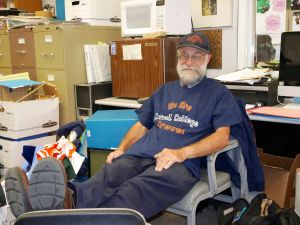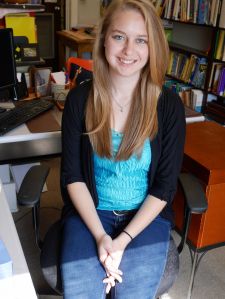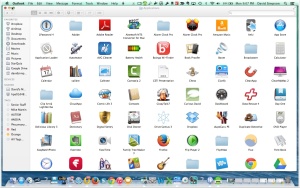








Amy Peterson
4 years ago, I anxiously started my career as a Psychology Research Assistant for none other than the “psychology professor with the big beard”, Dr. David Simpson. Our first encounter was delayed because after receiving my assignment and seeing his picture, I wasn’t sure if I wanted to work for him, what a typical precocious freshman I was! But after meeting him and learned the ropes from the God-like junior and sophomores, I finally began to feel comfortable in Dr. Simpson’s neighborhood. Looking back, I can hardly believe how much has changed. Time has transformed me, well, all of us really. Now sitting in the office, reflecting on my future after Carroll in December, I’m nostalgic for those years. From silly videos and webcasts, to struggling through SPSS for the first time, to Survey Monkey, and our pilot course in global connections through technology, our accomplishments are innumerable.
Dr. Simpson always brings light and fun into the office, even when he has stuff to do. He always makes time to check in with us, or joke about his Chi Tea Lattes, and of course telling stories about dear Robin, the Newf. Working with Dr. S has turned me from a precocious freshman, to a slightly-cynical, confident, and “sassy” senior with smarts to match-or so he lets me think! Our S-Team is my work family and as a senior, it’s especially odd that Phoumany and Ryan aren’t still here working with us as they had for 3 years prior.
Life in David land is a never ending adventure full of learning, fun and family.

Gracie Bubnik
My time in Mr. David’s neighborhood has been fairly limited because this is my first year. I had heard through the grapevine that there was a waiting list to become one of Dr. Simpson’s research assistants and somehow I was given one of the positions! At the time of receiving the email I was really excited to be given this opportunity! Then I was on mycarrollu.edu looking up my class schedule and realized he was one of my professors… I was terrified to begin my time as one of his research assistants. I was nervous that he would bring up class work during work and work during class. But we are here now, 2 months later, and I have found out that I can apply what I learn during work to my classwork and vice versa.
I know I haven’t been here as long as many of the other research assistants but I have found this little lab in the back of his office to be very comforting. And the family type relationship I have formed with the other research assistants and Dr. Simpson is something I look forward to keep building.

Jamilyn Smolik
I started this journey with Dr. Simpson in the spring semester of my sophomore year as one of his Psy205 students. At first, I was extremely intimidated by him because I was still a very shy, insecure underclassman with little self-confidence who had a lot to prove. I have learned that he is not as intimidating once you get to know him, and he is always around to help me out whenever I need it. After taking one of his classes, I was then curious if he had any openings for faculty assistants the following year. Because, I was not very assertive or timely, I waited to contact him the following fall when school began again. Long and behold, I received an email back saying he would enjoy having my help and welcomed me to his team.
After being shown the ropes from some helpful upperclassmen, I have grown to be quite comfortable when working in the office. I now also help the newbies get affiliated and comfortable with working in the office. I enjoy helping/working on ‘up and coming’ projects Dr. Simpson participates in outside of the Carroll environment. All of his projects provide great networking opportunities not only for himself, but for us, the student workers as well. As for the other student assistants, I have become very good friends with all of them. It is as if we are one, big, work family. We get on each other’s nerves at times, but just like family, we make up and act as if nothing ever happened. As I finish up my final year at Carroll, I look back and am so thankful for the opportunity I have been granted to work under Dr. Simpson, but also am grateful I took the initiative to push myself in a direction that will impact my future.

Maxine Venturelli
I remember as a freshman being assigned to Dr. Simpson as a faculty assistant for my work-study program. I took a breath and turned the doorknob into Dr. Simpson’s office to meet him for the first time. I was so nervous! What I did not know at the time was that I was walking into a place where I would make some great friendships and learn many things from the one and only Dr. Simpson. Starting off as acquaintances, they soon into my S-team family. See, these people are not just peers, but people who I look up to and admire. For the first few weeks working for Dr. Simpson, I was very quiet and shy, but that quickly changed. I slowly started to open up. Dr. Simpson takes the time to get to know each and every of his faculty assistants. He has challenged me to improve upon my weakness, while encouraging me to use my strengths. Over the years, there have been a multitude of projects that have taught me to collaborate with my fellow workers. Although, we did not always agree, we always ended up finding a solution in the end. One of the most memorable projects that we completed my sophomore year included creating our own course that focused on culture. Along with the project, we were each given an iPad. I loved participating in this project because I desire to become a teacher! Working with Dr. Simpson is a privilege. He involves us in projects and opportunities that are meaningful. I have so many memories that have accumulated over the years. My experiences here have shaped me into not only a better student, but a better person. When I graduate this coming spring, I will greatly miss the times spent in Dr. Simpson’s office.

Liz Firkus
Looking back on the past four years gives me such a bittersweet feeling. It seems surreal to think that in just a few short months I, along with several of the other S-Team members will be walking across the stage at graduation. I remember walking into Dr. Simpson’s office for the first time, feeling absolutely terrified. This did not last for long though, Dr. Simpson and the other S-Team members very quickly made me feel right at home. The first two years we had the same six S-Team members who quickly became my family away from home.
As an assistant, we always have work to get done, but Dr. Simpson makes sure that we have a fun time doing so. He is always filling us in on the latest stories about Robin, The Newf, his big black Newfoundland “pup”. Dr. Simpson, being an avid reader, makes it a habit of giving away books from his personal collection, so I always have a new book to add to my collection, a recommendation for something new to read, or someone to discuss Harry Potter with. Dr. Simpson has always played the role as a second academic advisor as well, giving advice about classes to take and what adjuncts he is familiar with and recommends. Working for Dr. Simpson has been an amazing experience that has taught me so much that I will take with me when I leave Carroll. Any future students will be extremely lucky to be one of his student assistants.





















